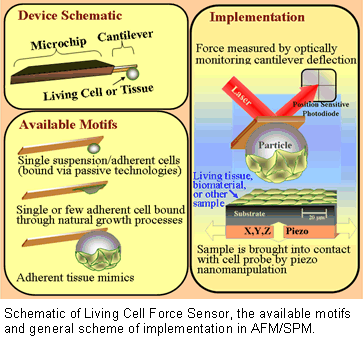Research Projects

Living Cell Force Sensors for Broad-based Bioanalytical Applications
R&D Team: Dr. Scott C. Brown1 and Dr. Brij M. Moudgil1,2
1Particle Engineering Research Center, 2Department of Materials Science and Engineering
Opportunity and Impact: The measurement of cell adhesion, or cell interaction forces, can be critical for the early diagnosis of disease, the design of targeted drug and gene delivery vehicles, the development of next-generation implant materials, and much more. Yet, the technologies and devices that currently on the market are highly limited with respect to the dynamic force range over which they can measure cell-cell or cell-substratum interactions, and with their ability to adequately mimic biologically relevant interactions. Consequently, research in cell adhesion has been technologically limited.

To meet the current scientific needs, we have utilized our background in nanoscience to develop living cell force sensor technologies (see schematic) that allow for the highly sensitive measurement of cell-mediated interactions over the entire range of forces expected in biotechnology (and nano-biotechnology) research (from a single to millions of receptor-ligand bonds). Moreover, we have several force sensor motifs that can be used to measure interactions using single adherent cells, single suspension culture cell, and cell monolayers (tissues) over a wide range of interaction conditions (e.g., approach velocity, shear rate, contact time, etc.). Hence we have the unique ability to provide tools for studying changes in cell adhesion behavior as a function of confluency, differentiation, and other highly important environmental and physiological factors that until now, were not easily achieved. Since the technology is new, a major factor limiting the commercialization is the need to establish the capabilities of the method with a wide variety of cell lines. Moreover, proprietary cell attachment protocols need to streamlined and modified to minimize the tedium involved in the fabrication of these force sensors.
Project Description: The successful commercialization of our product will necessitate (i) establishing efficient methods that can be used for higher volume fabrication of custom cell probes, and (ii) the development of materials and simplified protocols for end user cell attachment (e.g., living cell force sensor kits). The funding will allow the research team to demonstrate the following commercialization-critical capabilities:
- The ability to accommodate and utilize a wide variety of cell types on our force sensors (robustness & efficacy)
- Development of quick, simple, reliable and general cell attachment techniques (for all three motifs) that can be extended for high throughput cell force sensor fabrication
- The development of relatively simple and easy to use cell attachment protocols for force sensor fabrication that can be implemented into user kits.